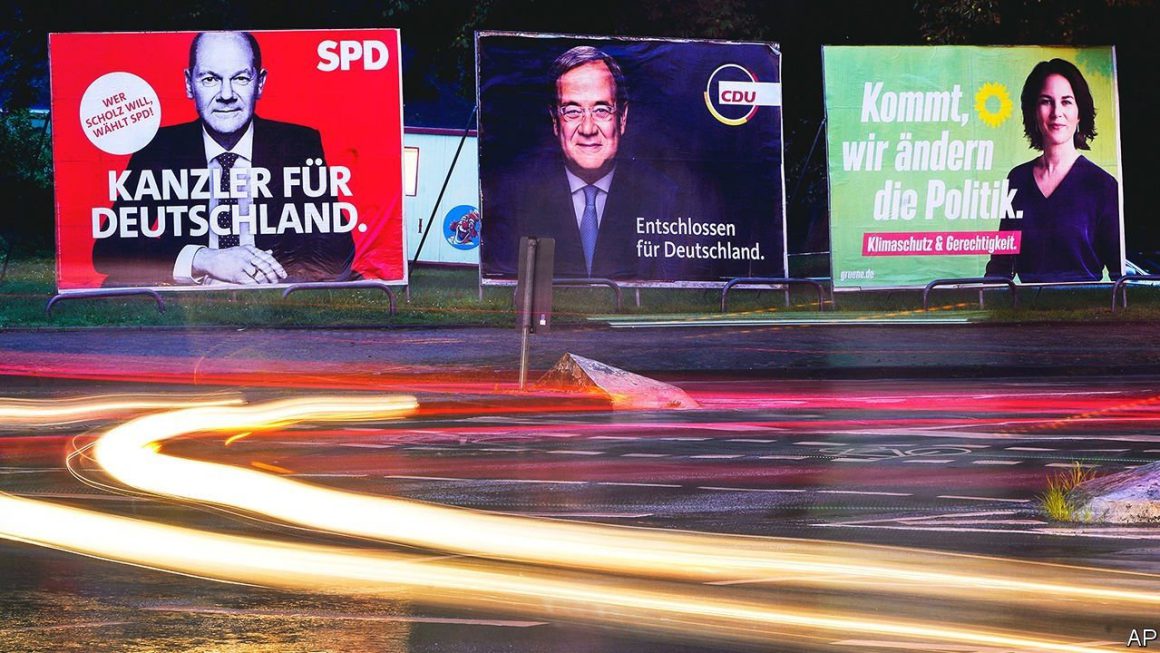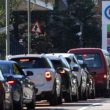By Claus Ludwig, Sozialistische Alternative (SAV) — our sister organisation in Germany
In the general election on 26 September, Angela Merkel’s conservative Christian Democratic Union (CDU) lost almost 9 percentage points and plummeted to 24.1%. The Social Democratic Party (SDP) won 25.7%, with the Greens on 14.8%, the liberal Free Democratic Party (FDP) on 11.5% and the right-wing populist Alternative for Germany (AfD) with 10.3%. Die Linke (the “Left Party”) lost half of its voters, ending up with just 4.9%.
The election has left the German political scene more unstable. The Social Democrats won, but not decisively. The Greens achieved their best ever result but fell short of expectations. The far-right AfD lost some support but stabilised its strongholds in Saxony and Thuringia. Die Linke’s disastrous result raises the question of what it should do next.
After years of humiliation, the SPD is seen to have scored a success, even though this is their third-lowest vote since 1949. Their leader, Olaf Scholz, embroiled in the CumEx and Wirecard financial scandals, a leading proponent of the “black zero” austerity policy which acts as a debt brake on budget spending as well as being boredom incarnate was the party’s flag-bearer in the snail’s race for the chancellorship.
In contrast to the Greens, the Social Democrats focused on linking Scholz’s personality with political content. On prominent and catchy posters, the SPD called for a “12 euro minimum wage,” and “secure jobs and climate protection”. Its candidate was presented as the “Chancellor for affordable housing” and “Chancellor for secure pensions”. The audacity of the SPD is breathtaking. It has been in government for 19 of the last 23 years and has not implemented any of these demands, but has done the opposite. It has lowered pensions, created one of the largest low-wage sectors in Europe, allowed the privatization of housing and the rise of real estate corporations, and been responsible for the underfunding of hospitals. Its posters tell lies — but at least they managed to state them clearly.
The decisive factor, however, was the role played by the CDU. In the 2013 and 2017 elections, alienation from the GroKo, the “grand coalition” of the CDU/CSU and SPD and dissatisfaction with the growing social injustice was blamed on the SPD, while the country’s relative stability was credited to Merkel’s CDU. This changed during the pandemic. The SPD was seen as responsible for the measures of state aid, while the CDU/CSU, also known as “the Union” suffered from the repeated failures of Health Minister Jens Spahn, and the crisis in the clinics, nursing homes and schools. Corruption was also seen as an issue.
Following an election victory like this, those people who want to further their political careers get interested in joining the party. This could interrupt the long-term shrinking of the SPD for a period. But a revival of the SPD in the sense of being a party associated with the workers’ movement is not on the cards.
CDU: Not yet destroyed, but …
The crisis of the “Union” reflects the alienation from all established parties, especially from the CDU. During the pandemic, the “Union” was perceived as the power-hungry, corrupt force acting in the interests of “the economy” that it has always been. Corporations were generously given billions of euros — and, like Daimler, continued to pay dividends to shareholders, while people working in culture and hospitality were left fearing for their existence. Parents and kids were under enormous pressure. The enrichment of corrupt CDU deputies from deals with corona masks and their complete incompetence during the flooding a few weeks before the election were the last straws in demonstrating their political negligence.
The “Union” is increasingly becoming a party of the elderly, small towns and villages. Among those older than 70, the “Union” achieved 38%, among those younger than 25 only 10%, with just 14% of under 35s supporting them.
The mood in society has moved to the left on important issues, regarding equal rights for women, LGBTIQ+ rights, also on the issue of the (re)distribution of wealth, climate and tax justice. Anti-racist sentiments are stronger among the younger generation. At the same time, a minority has polarized to the right, some voters have migrated to the AfD.
For decades, the “Union” has been the most reliable partner for German capital. Its electoral support was based on its reputation as a “people’s party” in which the interests of capitalists, petty bourgeoisie, workers, and the peasant population are supposedly reconciled. This has increasingly come into conflict with reality.
With the defeat of 26 September, Merkel’s phase of a stable CDU government “for all” is over. Internal tensions and conflicts are on the rise. The brutal neoliberal camp around Friedrich Merz has more supporters in the party than among the voters and will demand tougher measures in the interests of the corporations. The wing around the right-wing populist Werteunion (“Union of Values”) will launch a nationalist offensive and wants to prepare the ground for cooperation with the AfD, pushing this forward especially in the east German states. Tactically, the most flexible seems to be the Bavarian CSU around Markus Söder, which is able to talk with the Greens about modernizing capitalism and, at the same time, plays the right-wing card of hostility against migrants.
The hegemonic phase of the “Union”, the times when it was far ahead of other parties, scoring well above 30 or even above 40%, are over. It cannot be ruled out that centrifugal forces will become so strong in the next few years that it will break apart and new bourgeois formations will emerge.
Class issue of abstention
In conversations on the street, many people said that CDU/CSU should finally be voted out of office. However, there was no mood of change in the form of a tangible alternative as in 1998, when the SPD and the Greens ended the era of former CSU-Chancellor Kohl. More voters consider all coalition models to be “rather bad” than “rather good”. According to a ZDF poll a week before the election, 37% support a ”traffic light“ coalition (SPD-Greens-FDP), 34% support a grand coalition under SPD leadership, 30% under CDU leadership, 30% support a ”Jamaica” coalition (CDU-Greens-FDP) and 27% support R2G (SPD-Greens-Die Linke).
Voter turnout increased only slightly compared to 2017, from 76.2% to 76.6%. In 2017, the “others” achieved 5.0%, in 2021 8.7% of the vote. Germany has a 5-percent threshold. Parties that receive less than 5% — just over 2 million votes — get nothing in parliament. These 4 million “others” and around 14 million non-voters mean that 29.5% of the 62.1 million eligible voters are not represented in the Bundestag (German Parliament). There are a further 8 million people of voting age without a German passport who are denied participation. The Bundestag thus represents the votes of 62% of the population over the age of 18. A governing coalition, for example a “traffic light” of SPD, Greens and FDP would be based on the votes of 37% of eligible voters and 32% of the over-18s (including non-Germans).
Both the exclusion of non-citizens and abstention from voting are class issues. Among production and service workers, non-voters are the strongest “party.” In these areas, the proportion of foreigners is also higher. Horst Kahrs in his election analysis for the Rosa Luxemburg Foundation, which is connected to Die Linke comments:
“A significant number of members of the ‘working classes’ involved in the social production of wealth are not allowed to participate in the election. This, together with the high level of abstention from voting among the ’German part’ of the working class, means that much of the reality of life experienced by the production and service professions finds no reflection in the political system”.
Greens depoliticized
The Greens performed poorly especially compared to what was predicted at the beginning of 2021. Similar to the situation around the CDU, a debate has opened up about personalities. “Baerbock can’t be chancellor” was the tenor of the discourse led by the other parties and in much of the media against the Green’s top candidate Annalena Baerbock. In part this was based on sexist stereotypes. However, it is not the Green candidate who is the problem, but the abandonment of the Green’s climate protection program in anticipation of the need to obey any future coalition agreement and the depoliticization they themselves have pursued.
Even before this, the electoral program of the Greens was not sufficient to effectively protect the climate. It contained nothing that could have led to the transformation of production, or intervene to curb the power of the corporations. With its “immediate program for the protection of the climate for the next federal government” presented at the beginning of August, they went one step further. It barely provides for government intervention or public investment, but is reduced to the use of control measures for the ecology through prices and company subsidies, a method that has long since failed.
Few will have read these programs, but the Greens’ entire election campaign was conducted at snail’s pace, based almost entirely on trying to encourage a good mood. Posters like “There’s no way around the climate goals. Ready, because you are” showed an almost satirical contempt. Obviously, there are many ways around the climate goal — those of the energy company RWE, the car companies, the CDU/CSU, the SPD…
According to surveys, people’s greatest concerns are about the climate. However, more often than not, social issues were mentioned as being the decisive factor in the election. The Greens are perceived as a party that is not interested in precarious workers, the unemployed and the poor. They have no answers to concerns about higher energy prices. At the same time, they have talked down the urgency of the climate crisis and promoted the illusion that it can be solved through higher taxes, prices and in coalition with those parties, which are directly linked to the coal and car companies.
FDP disguises itself with modernity
As a bourgeois option, the liberal FDP always benefits from any crisis affecting the CDU/CSU, and this time is no exception. It was able to present itself as being in moderate opposition to the Corona measures and score points with younger voters with its alleged modernity and affinity for digitization, which it uses to camouflage its tough neoliberal program of tax cuts for the rich and corporations. Its party leader, Christian Lindner, pretended during TV debates to take the climate issue seriously and, contrary to the truth, claimed that “the market” and the technologies to be developed by private corporations could solve the problem. In doing so, he played on the fears of many that action on climate change could drastically affect their lifestyles. The fact that he was able to spread this narrative is mainly because the Greens did not counter it. For they too, believe “the market” can solve the problems, albeit with more regulation.
The AfD, which has clearly moved further to the right, is losing slightly nationwide, but is consolidating its vote in its strongholds. It performed poorly in some areas, especially in major cities such as Hamburg, Munich, Cologne and Frankfurt — in Berlin its vote almost halved. But it became the strongest party in Thuringia under its fascist leader Björn Höcke with 24%, and in Saxony with 24.6%. In the latter, it won almost all the directly elected constituencies. This consolidation of the AfD as a supposed anti-establishment force is a warning for the left and the workers’ movement, it will promote racist division and right-wing violence.
Die Linke in crisis
Die Linke fell below the five-percent hurdle. It enters the Bundestag with 39 deputies only because according to electoral rules, this barrier is lifted if a party wins three direct mandates. It did this by winning them in Berlin and Leipzig. The party lost most percentage points in its former strongholds in eastern Germany, where it slipped behind the AfD, and in Brandenburg even behind the Greens. But it has lost about 50% of its electorate across the board in most of the federal states.
Die Linke had adopted a relatively good election program, with proposals against climate change that would be far more effective than those of the Greens. But its election campaign strategy virtually hid this program. The “social question” was brought to the fore, but in a way that barely differed from that of the SPD.
As the election approached, and the mirage of a possible red-red-green (SDP-Die Linke-Green) coalition appeared on the horizon, the party leadership emphasized that it wanted to join the government and declared its party principles to be negotiable or obsolete. Shortly before the election, leader of the parliamentary faction Dietmar Bartsch and co-chairwoman Susanne Hennig-Wellsow declared that their goal would be to freeze arms spending at 2018 levels, even though it had been rising for several years before that. This change of course meant that many chose to vote for the original SDP, rather than its shadow, even if only for ‘tactical’ reasons.
Many of Die Linke’s demands are popular. Election researchers have pointed out that the difference between real and potential votes is greatest for Die Linke. It managed to mobilise less than a quarter of its possible 20% vote. The 10.3% gained by the AfD, in contrast, was two-thirds of its potential. This was particularly clear in Berlin, where a large majority of 57% voted for the referendum on expropriating the housing corporations, but only 14.1% voted for the Die Linke, the only party that clearly supports this demand.
Practical experience with Die Linke in state and regional governments, where it has participated in implementing cuts, has long since eroded the party’s appeal. The tactical change just before the election was the last straw which pushed Die Linke below the 5% hurdle. As the election campaign ended up as a duel between the SDP’s Olaf Scholz and the CDU’s Armin Laschet”, the left vote, including many former Die Linke supporters, mobilised behind the SDP. According to preliminary estimates, Die Linke lost a total of 2 million votes, including 640,000 votes to the SPD and 480,000 to the Greens.
In this situation, the party, in order to exploit its full potential, should have acted as a strong opposition to all pro-capitalist parties, positioning itself to become a thorn in the side of any Bundestag government. Its aim of co-governing was strategically wrong. Not only because the party would have been restricted in implementing its program in government, and could have achieved more by mobilising active opposition. As a short-term tactical perspective it proved fatal.
The Wagenknecht factor
This alignment of the party leadership with the establishment was compounded by the sniper actions of the party’s best-known representative, Sahra Wagenknecht. Wagenknecht acted against her own party. Her approach. which she herself calls “left-wing conservative” is at best a throwback to 1960’s social democracy. Worse, it encourages people with racist prejudices to consider them “normal.” Wagenknecht and her supporters do not talk about class struggle. In doing so, they separate the “social question” from the struggle against the different forms of discrimination, counterposing them as if precarious workers in particular are not also subject to racist or sexist oppression.
The election debunked the myth that Wagenknecht has created a “bandwagon”. She was Die Linke’s lead candidate in North Rhine-Westphalia, Germany’s largest state with 18 million inhabitants, and spoke at many relatively well-attended rallies. However, Die Linke losses in this state were slightly above average, the vote fell from 7.5 to 3.7% with a loss of half its electorate — 370,000 voters.
The election was not lost mainly because of Wagenknecht. But it is true that many will not have voted for Die Linke because of Wagenknecht, others because there is opposition to her in the party. More seriously, her actions have damaged the party and repelled anti-racist, feminist and climate activists, and demoralized active party members.
So-called “reformers” are strengthened
SAV, the German section of ISA, has always described Die Linke as “two parties in one,” with a militant anti-capitalist section, and the “reformers” who aim to establish themselves as a parliamentary party, supplementing themselves to the SPD and Greens. With the development of Wagenknecht’s “left conservatives,” we now have to speak of a roughly tripartite party that, in addition to the more anti-capitalist and movement-oriented pole, there are two partly competing, partly cooperating reformist wings.
Die Linke has been held together by its past successes. The loss of mandates and less rosy prospects for coming elections will subject the party to acid tests, the outcome of which is currently uncertain. The resignation of members and splits are possible. Moreover, the Bundestag faction is further to the right on the party’s spectrum than the previous one, and certainly more right-wing than most activists. The vast majority of deputies are either Wagenknecht supporters or “reformers”. The latter will interpret the slightly better performance in Berlin, where Die Linke is in coalition, as a mandate to emphasise the government perspective even more.
One task of the left-wing is to prevent the creeping retreat of frustrated activists and to develop perspectives on how the party can be changed. In some districts in Berlin — especially in Neukölln, where SAV member Lucy Redler ran — Die Linke achieved excellent results with a clearly anti-capitalist election campaign, based on long-standing roots in the district. At the grassroots level, the party has become younger and more militant everywhere. So another party is possible.
However, activists should not become too inward-looking, spending their time in the struggle for majorities at internal party meetings. Party activists are needed in the movements, for the enforcement of the rent referendum in Berlin, for the strengthening of the anti-capitalist pole in the climate movement, for the struggle for a change in transportation, to support protests in the health care system and against attacks on the rights and incomes of wage earners. The struggle for a clearly oppositional, anti-capitalist Die Linke must be closely linked to the strengthening and political development of these movements.
Coming conflicts
The Greens, who will probably join a coalition in the future, say — quite justifiably — that this legislative period will be decisive for whether effective measures against climate change are taken. Given the coalition options available, it is clear that this will not happen.
The most likely option is the formation of a government of Social Democrats, Greens and the liberal FDP. The FDP is a hard-line neoliberal party. It will propose attacks on workers’ rights and incomes, and will at least prevent the imposition of taxes on the rich and corporations. It will try to block the timid proposals of the Greens and the SPD to increase public investment. It is also not impossible that the negotiations will fail and the Greens will form a government with the CDU/CSU and FDP election losers, possibly led by CSU leader Markus Söder.
Fridays for Future has so far organized huge demonstrations, most recently with 600,000 participants two days before the election. However, it only appeals to “the politicians” to take action. The climate movement must now strategically discuss how to move from appeals to struggles that unleash pressure and force action. Crucial to this is the linkage between the workers’ movement and the class question.
The climate crisis, however, will be used by the government to promote rising energy prices and taxes, or to justify layoffs and plant closures. The measures of the coming government will not be at the expense of the main polluters of emissions — the corporations — but will be imposed on wage earners. The plans for higher taxation of the propertied classes, which can be found in the election programs of the SPD and the Greens, will be implemented, at best, in a version slimmed down beyond recognition.
In the shadow of the pandemic, moreover, the rights of wage earners are coming under fire. The abolition of the payment of wages for unvaccinated workers during quarantine does nothing to protect against infection. Instead, it is the beginning of the overall phase-out of such support. The polling by companies of workers’ vaccination statuses — officially in some areas, factually in others — erodes the protection of individual’s health data.
The fundamental problems of capitalism, which is currently experiencing a temporary interlude in its ongoing crisis, pose major problems for the ruling elite. The rich and corporations have a long list of wants that they want the government to work on that will lead to conflict with the workers. At the same time, the government is weak. It is expected to consist of three parties and thus has several potential breaking points.
The phase when Merkel’s policy of wait and see dominated is over, not just for the CDU. This federal election marks the beginning of a new phase of political uncertainty. The left in general and Die Linke in particular must learn the lessons of the wonderfully successful Berlin referendum on the expropriation of housing corporations. It needs to discuss where the success can be repeated, but above all how it can fight for the implementation of the result of the referendum. The strikes by workers in the clinics, and in Berlin, point to the determination with which the workers’ movement should go into the coming conflicts.











